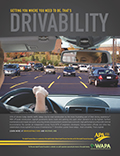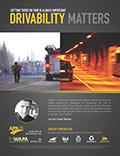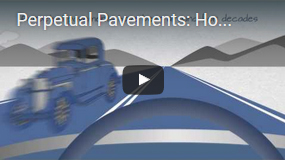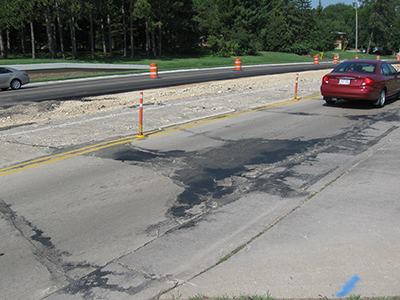
It’s paving season and we know you’re busy. This brief Executive Update discusses new informational materials about asphalt pavements and the importance of communicating the benefits.
A Transportation System in Need—Asphalt is the Answer
Get Engaged
WAPA is an active participant in the Asphalt Pavement Alliance (APA), a coalition of state and national asphalt pavement trade associations dedicated to establishing asphalt pavement as the preferred choice for quality, performance, and the environment.
Through the efforts of APA, WAPA has compiled and published materials to help communicate the many benefits of asphalt pavements. These appear on our new Marketing page on our website, wispave.org.
Print Ads
Nine advertisements themed around “Drivability” draw on the voices of asphalt users and experts to highlight such benefits as enhanced safety, reduced road noise, ease of construction, and reduced traveler delays. Created by APA, these ads are high-resolution and appropriate for print reproduction, with several available in full- and half-page sizes. All are customized with WAPA branding, including our logo and website. (WAPA members, we can provide design files if you would like to further customize these for your informational campaigns.)
 Less Road Noise |
 Ease of Maintenance |
 Every Minute Counts |
Videos
APA also produced six short (one- to two-minute) videos that dynamically illustrate the beneficial features of asphalt. These YouTube videos are easily embedded and shared in any website, providing an outstanding complement to the print materials.
 Asphalt: The Answer to Road Age |
 Perpetual Pavements: How to Design a Road to Last |
We’ll provide updates when we add new materials to WAPA’s Marketing page. We hope you find these items informative and useful.

Though some of the headlines are shocking—“Deficient roads cost Wisconsin drivers $6 billion annually”—the concern is not new. We have been writing for months about TDA’s campaign to Just Fix It (see below on how to join that campaign if you haven’t done so yet). Certainly, not all of the challenges in the report can be solved with asphalt.
However, the communication materials described in the previous article help explain how asphalt pavements can address some of these core concerns.
- Safety.
Many factors come into play when it comes to crashes, but asphalt can play a starring role in making the roads themselves safer. This is particularly true for the rural roads that By the Numbers reports are now twice as dangerous as urban ones.
Asphalt creates the smoothest surface for driving. Smooth roads allow superior contact with vehicle tires for a safer (and more enjoyable) ride. Open-graded asphalt, a special type of road surface, can minimize splash and spray during rainstorms and reduce crashes and fatalities on highways.
“With asphalt, it is easy to ensure a consistently smooth level of performance; which saves lives, wear and tear on your vehicle, and can improve vehicle fuel economy by 4.5%.” (Drivability: A Smooth Road).
- Economics.
In our biggest cities, it costs the average driver about $2,000 annually due to the poor road conditions, according to By the Numbers. Investing in highway renewal with asphalt is a sure way to give motorists the roads they deserve while easing the hit to their wallets.
Smooth roads aren’t just safer, they also save money. Reduced wear and tear on vehicles due to fewer bumps in the roads brings down vehicle operating costs. Also, increasing a roadway’s smoothness by 25 percent extends its lifespan—upwards of 10 percent—which saves taxpayers money. Asphalt roads can be built more quickly and cost-effectively than other pavements as well, and they can be designed as a Perpetual Pavement that needs only periodic maintenance to remain in good shape indefinitely.
“Rough roads increase vehicle wear and tear. It all adds to business costs and purchase prices. Asphalt pavements are easy to maintain cost-effectively.” (Drivability: Business-Friendly).
- Sustainability.
Deficient roads cost Wisconsin drivers $6 million annually, By the Numbers reports. The largest portion of this, $3.3 billion, is due to additional vehicle operating costs such as accelerate depreciation, added repair costs, wasted fuel, and tire wear that motorists incur by driving on inadequate roads.
Smooth asphalt roads reduce rolling resistance (the friction between tires and pavement), which means better fuel economy and reduced carbon dioxide emissions. The asphalt industry reuses and recycles nearly 100 million tons of asphalt pavement a year, saving taxpayers an estimated $2.8 billion annually.
“Asphalt pavements are 100 percent recyclable and can be produced with energy-saving warm-mix technologies. That makes asphalt the sustainable choice.” (Drivability: The Sustainable Choice).
- Mobility.
By the Numbers reports that 36 to 38 hours a years are lost to Madison and Milwaukee motorists from traffic congestion. Much needed pavement repair doesn’t need to mean gridlock. Asphalt can keep traffic moving and get the job done quickly.
Asphalt roads can be paved just a lane at a time, minimizing disruption to citizens and reducing congestion through speedy construction processes. This saves taxpayers thousands of dollars in user costs. Projects can often be completed in one short day, or even overnight, leaving routes open for travelers and providing street access for stores and businesses.
“With off-peak construction, asphalt pavements leave roads open to traffic during rush hour. Surface maintenance and repair is quick, ensuring drivers have a smooth, high performance surface with minimal inconvenience.” (Drivability: Reduced Delays).
These are just a few of the ways that asphalt can make a real difference in tackling some of our state’s challenges. Look to WAPA’s resources on our website—or contact us—to learn more about the advantages of asphalt roads.

Visit the Just Fix It page on the TDA website to join the grassroots effort to convince elected officials to act on transportation funding.
It only takes a few minutes to sign up to send a letter to your officials calling on them to find a long-term, sustainable funding strategy for Wisconsin transportation. TDA creates a new letter every month.
(Are you on the go? Then simply text JustFixItWI to 52886. You’ll receive a link to the same page.)
It’s that easy to get engaged and let your voice be heard. We strongly urge you to please consider joining this effort to tell our elected officials that they should Just Fix It when it comes to transportation.
Thanks for taking the time from your busy summer to give some thought to the importance of communicating the value of asphalt pavements, particularly to help address some of our state’s most challenging transportation issues. It’s a message that bears emphasizing and repeating.
The pillars of Wisconsin’s economy—agriculture, manufacturing, and tourism—depend on our roads. These industries, plus retail sales and other transportation-dependent industries, account for almost 1.4 million jobs in Wisconsin, with $54.8 billion in wages. Our transportation system is too important to ignore.
As always, please don’t hesitate to contact us if you have any questions or if there is ever any way we may be of assistance.
Thank you.

Brandon Strand
Wisconsin Asphalt Pavement Association




